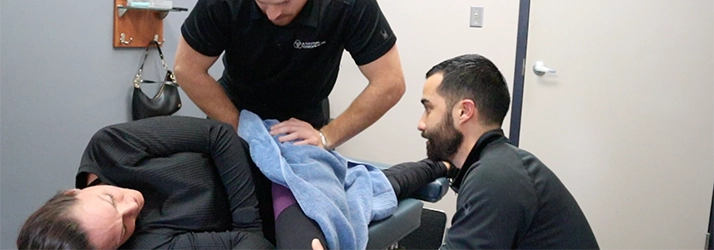Psoas Muscle Stretches for Back Pain Relief
(Best Release Techniques)

Many of our chiropractic patients come to us complaining of lower back and hip pain that impacts every part of their life. Some people experience this pain as a dull ache while others feel a sharp pain. Either way, it's not an enjoyable experience and oftentimes the root of the problem is the psoas muscle, a muscle you've probably never heard of.
In this article, we'll discuss some psoas muscle back pain and release techniques. The psoas muscle and back pain go together like peanut butter and jelly so let's explore this incredibly important muscle, how it can cause back pain, and what can be done to ease that pain.
What is the Psoas Muscle?
The psoas muscle (pronounced SO-as) is one of the most important muscles in your body. You use it every day and you probably wouldn't even be able to get out of bed without it! The psoas muscle is a lower back muscle located very close to the spine and inside of the hip and thigh bones.
The psoas starts on the side of the lumbar vertebrae and, making a triangular shape, tapers down into a tendon that connects to the top of the thigh bone. On its way to the upper thigh, the psoas meets up with another muscle called the iliacus. The iliacus is a large, flat muscle that sits on the inside of the front of your hip bone. The illiacus and the psoas muscles (called the iliopsoas muscle) work together to flex the hip joint. The psoas muscle is located deep inside your core and is one of the primary connections between your torso and your legs so it plays a vital role in back health and mobility.
Your psoas muscle allows you to bend your hips and legs towards your chest the way you need to in order to climb stairs. It also helps you move your leg forward when you walk or run and flex your trunk when you bend over to lift something. The psoas muscle isn't just for movement though, it also supports your internal organs and stabilizes your spine.
The Psoas Muscle and Back Pain
More often than not, when patients come to us with back pain it involves the psoas muscle in some way. The psoas muscle can weaken due to a sedentary lifestyle which is an increasing risk with more and more people sitting for most of the day. Even something seemingly non-strenuous like sitting at your desk all day can contribute to the weakening of your psoas muscle. When it isn't used frequently enough, your psoas can stiffen and reduce your mobility in addition to causing back and even hip pain.
Some people wind up with psoas issues through strain, spasms, tendonitis, or contractures. Many people injure their psoas muscle by twisting their torso with their feet planted, ballet-style leg lifts, straining while doing sit-ups, or really with any movement that causes your leg to externally rotate while it is extended.
Back pain that stems from psoas contraction can be very painful and doesn't seem to want to go away. Many people experience increasing pain that radiates from the torso into the chest and hip area and it's hard to escape because the psoas is not a muscle you can just choose not to use. We see these sorts of injuries in a range of people from very active athletes to office workers who aren't very active.
Whenever the psoas muscle contracts, it pulls the spine into a condition known as hyperlordosis. The muscle pulls and shortens the spine into an over-arched position that puts a lot of strain on your spinal muscles. When the psoas contracts, it strains your vertebral joints which results in back pain.
A contracted psoas muscle will also cause compression of the spinal discs and joints because the muscle pulls and twists the vertebrae, which leads to compression. Spinal compression causes significant pain and can do long-term damage to the spine if left untreated. In addition to long-term structural damage to your spine, spinal compression can also lead to degenerative disc diseases and sometimes herniation. In short, this isn't just back pain, it is an issue with one of the most important muscles in your body that has influence over many other parts of your body.
What to Do if You're Experiencing This Kind of Back Pain
Because your psoas muscle is such a workhorse of a muscle for your day-to-day life it can be very debilitating to have problems with it but we have plenty of psoas muscle back pain release techniques that we can use with patients to reduce their pain and heal their psoas muscle. If you're experiencing the kind of back pain and hip pain we've described, we highly recommend making an appointment to see one of our doctors because this is a pain that tends not to just go away on its own. In fact, it can get worse and more intense over time.
In addition to easing your pain, our doctors can help you strengthen your psoas muscle so you can avoid having to face this kind of pain in the future. We can give you a variety of stretches and exercises you can do at home to strengthen your psoas muscle, ease back pain, and prevent future injury. Click here to schedule your appointment!
OFFICE HOURS
Monday
7:30am - 12:00pm
2:00pm - 6:00pm
Tuesday
7:30am - 12:00pm
2:00pm - 6:00pm
Wednesday
7:30am - 12:00pm
2:00pm - 6:00pm
Thursday
7:30am - 12:00pm
2:00pm - 6:00pm
Friday
7:30am - 12:00pm
Saturday & Sunday
Closed
Kalkstein Chiropractic
200 E Joppa Rd #300
Towson, MD 21286
